How and what is tofu made of? Tofu, also called soybean curd, is a key ingredient in many Asian dishes. It starts with soybeans and offers a versatile, nutritious plant-based protein. Curious about the ingredients and production process? In this post, we’ll explore what tofu is made of and how it is made.
Introduction to Tofu: Definition
Tofu has been enjoyed in Asia for centuries, long before its recent discovery in the West. A plant-based food made from soy beans and water, tofu stands out as an excellent source of soy protein, calcium, and other essential minerals. Its versatility shines through as it can be incorporated into various dishes, from soups and stir-fries to sandwich spreads and even desserts. Tofu’s nutritional profile makes it a great addition to vegan diets, providing a complete protein with all nine essential amino acids.
What Is Tofu Made Of?
First things first, let’s talk about what tofu is. Tofu, a popular soy-based food, is made from soybeans, which are known for their high protein, iron, and calcium content. Soybeans are a good source of antioxidants and phytochemicals, and they serve as the main ingredient in tofu.
This protein-rich food is also low in fat, making it a healthy option for those looking to increase their soy protein intake. Tofu comes in different types, from soft silken tofu to extra-firm tofu, offering various textures that cater to different uses in cooking. The type of dish you are looking to cook will determine the type of tofu.

History Of Tofu
Tofu, also known as bean curd, is a plant-based food that has been used in Asian cuisine for over 2,000 years. It is believed to have originated in China during the Han dynasty (206 BCE – 220 CE) and later spread to other parts of Asia such as Japan, Korea, and Southeast Asia.
The spread of Buddhism across Asia played a significant role in the popularity of tofu, as it provided a reliable source of plant-based protein for vegetarians and vegans. Over time, tofu has become a staple food in many Asian markets and is now widely available in Western grocery stores.
| Year | Event |
|---|---|
| 2nd century BCE | Tofu is believed to have originated in China during the Han dynasty |
| 6th century CE | Tofu spread to Japan through Buddhist monks |
| 16th century | Tofu becomes a popular food in Japan |
| 19th century | Tofu production begins in the United States |
| 20th century | Tofu becomes widely available in Western countries |
| Today | Tofu is enjoyed as a staple food and ingredient in many cuisines around the world |
Buddhism’s spread in Asia played a vital role in Tofu’s popularity, as it is a good source of plant-based protein for vegetarians and vegans. Tofu’s versatility as an ingredient also made it a staple food, as it can be used in a wide range of dishes such as soups, stir-fries, salads, and even desserts. The West has recently embraced tofu’s popularity. Recognizing it as an excellent protein source for vegetarians and vegans. Many consider it a healthier alternative to meat.
What Is Tofu Made Of: Soybeans – The Main Ingredient of Tofu
Soybeans, the main ingredient in tofu, are highly nutritious and offer numerous potential benefitsThey contain essential amino acids, vitamins, and minerals, and have been consumed for centuries in various forms, including fresh tofu.
Soybeans provide the base for tofu, acting as a blank canvas that absorbs flavors and takes on different textures, from the creamy consistency of soft silken tofu to the firmer tofu that holds up well in stir fry dishes. The soybean curd created from the coagulation process is pressed into a block of tofu, which can then be sliced, diced, or used whole in a variety of dishes.
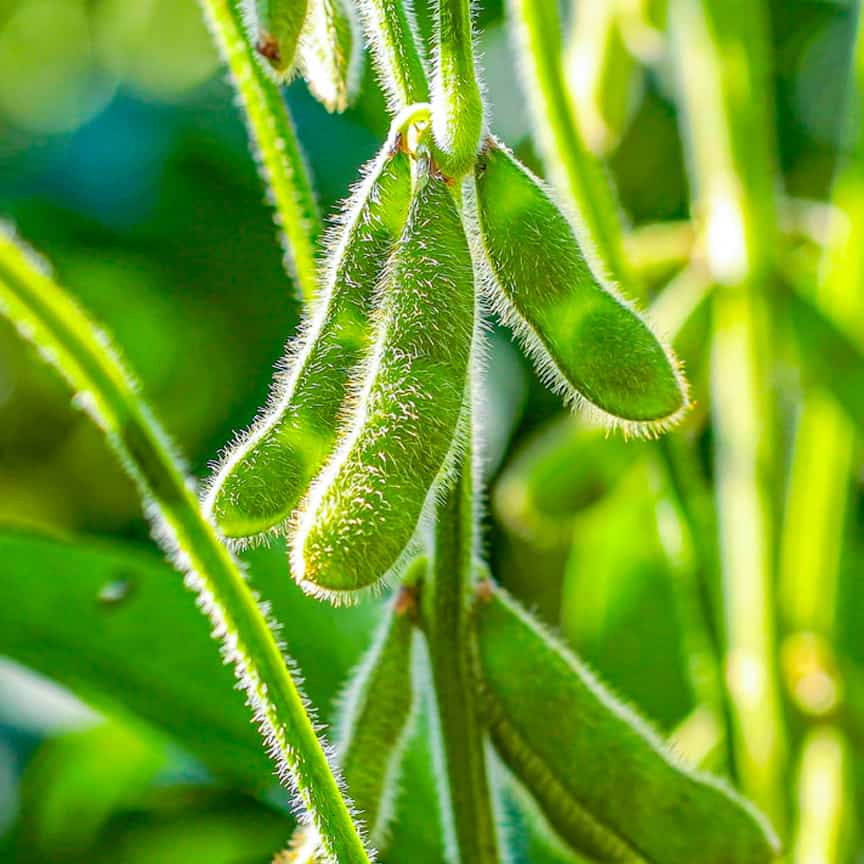
To make tofu, first, soak soybeans, then grind them into a paste. Next, filter the paste to separate the solids (okara) from the liquid (soymilk) to create the foundation of tofu.
Coagulants – The Secret Ingredient in Tofu Production
The next step in the tofu production process involves adding coagulants to the fresh soy milk. Coagulants such as nigari (magnesium chloride) and gypsum (calcium sulphate) are added to the soy milk to cause it to solidify. The amount of water in the tofu is determined by the type of coagulant and the pressing process, with firmer tofu containing less moisture. This step is crucial for achieving the desired texture of tofu, whether you’re making homemade tofu or purchasing store-bought tofu.
The Production Process of Tofu: The Process of Making Soymilk
The production of tofu begins with soaking soybeans in water for several hours or overnight, then grinding them into a fine paste. This paste is mixed with water and filtered to separate the solids (okara) from the liquid, resulting in fresh soy milk. This fresh soy milk forms the foundation for tofu.
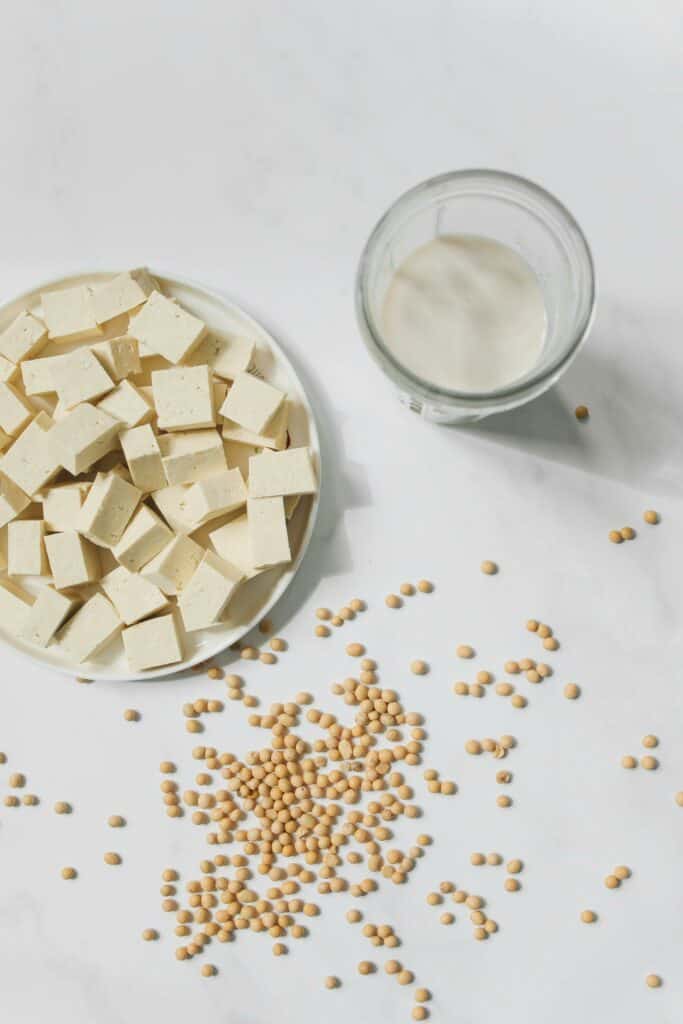
The Process of Coagulation
Next, the soy milk is heated, and coagulants are added. This causes the soy milk to curdle, forming curds and whey. The curds are then pressed to remove excess liquid and shape the tofu into blocks.
The Process of Pressing and Packaging
The final step in the tofu production process is pressing the curds to remove any remaining whey and form a block of tofu. This step is essential for achieving the right moisture content and texture of tofu. The tofu is then cooled, packaged, and sold in grocery stores or tofu shops.
Types of Tofu
| Tofu Type | Description | Best Uses |
|---|---|---|
| Silken Tofu | Japanese-style tofu with a silky, creamy texture and high water content; versatile for sweet and savory dishes. | Used in recipes requiring a creamy texture, such as cheesecakes, smoothies, and dips. |
| Regular Tofu | Compact and soft tofu suitable for Asian dishes; absorbs flavors well; used in noodle soups and spreads. | Ideal for noodle soups, stews, and spreads; not suitable for pan-frying or deep-frying. |
| Firm Tofu | Versatile tofu available in supermarkets; compact and easy to chop; suitable for various cooking methods. | Used in pan-frying, stir-frying, deep-frying, stews, and spreads; requires thorough drying before cooking. |
| Extra-firm Tofu | Tofu with less water content than firm tofu; suitable for cooking; doesn’t absorb marinades as well. | Great for pan-frying, stir-frying, and deep-frying; choice depends on personal preference. |
| Super-firm Tofu | Dense tofu with a meat-like texture; suitable as a meat substitute; easy to prepare. | Suitable for meat-like textures; natural and pre-seasoned options are available. |
| Pressed Tofu | High-pressure pressed tofu with minimal water content; akin to super-firm tofu. | Used in various dishes such as soups, sushi, and stir-fries; pre-seasoned options are available. |
| Fermented Tofu | Tofu fermented in a mixture of salt, rice wine, and water, resulting in a deep, savory umami flavor. | Used as a flavoring agent in Chinese cuisine; avoid plastic packaging for fermentation preservation. |
| Tofu Skin | Thin skin that forms when heating soya milk, available in dried form; versatile for pan-frying, filling, or dim sum. | Ideal for creating crispy wraps or spring rolls; used in various Asian dishes. |
| Tofu Sticks | Extra-firm tofu with a smoky flavor often smoked over beech wood; ideal for raw consumption or cooking. | Add to miso soup for texture and flavor. |
| Fried Tofu | Firm tofu slices that are pressed and deep-fried; sponge-like texture absorbs marinades and sauces. | Pre-seasoned tofu is available in different flavors; convenient for various cooking methods. |
| Tofu Pockets | Also known as ‘tofu pockets’; briefly boiled, dried, and used as envelope-like containers. | Convenient for stuffing and serving; adds a unique twist to dishes. |
| Tofu Puffs | Frozen and deep-fried tofu balls with a sponge-like texture; quick to absorb marinades and sauces. | Perfect for quick preparation; suitable for dipping or filling; delicious raw. |
| Seasoned Tofu | Sun-dried and rolled tofu skins; are great for miso soup filling. | Easy to use; suitable for pan-frying, stir-frying, grilling, roasting, or eating raw. |
| Smoked Tofu | Pre-marinated and pre-cooked small tofu pieces; are convenient for adding to dishes. | Adds a smoky aroma to dishes; suitable for pan-frying, stir-frying, or using in salads and stews. |
| Tofu à la Minute | Pre-marinated and pre-cooked small tofu pieces; convenient for adding to dishes. | Easy to incorporate into stir-fries, salads, and stews; available in various flavors. |
The Process of Making Tofu: What Is Tofu Made Of
The process of making tofu begins with soaking, grinding, and boiling soybeans. Cook soybeans until soft, then press them into a thin paste. Pour the paste into molds and let it set. Cut the tofu into cubes or rectangles and use as desired. It can be served in many creative ways. From vegan salads to desserts!
| Step in Tofu Making Process | Description |
|---|---|
| 1. Soybean Selection and Soaking | High-quality soybeans are selected and soaked in water for several hours or overnight. This softens the beans and prepares them for grinding. |
| 2. Grinding and Boiling Soybeans | The soaked soybeans are ground into a fine paste using a blender or mill. The ground soybeans are then cooked in water to create soy milk. |
| 3. Coagulating and Curdling Soy Milk | Coagulants such as nigari (magnesium chloride), gypsum (calcium sulfate), or calcium sulfate are added to the soy milk. This coagulates the proteins, causing the soy milk to curdle into solid curds and liquid whey. |
| 4. Pressing and Shaping the Tofu | The curdled soy milk is transferred to a tofu mold lined with cheesecloth or tofu press. Pressure is applied to remove excess whey and shape the curds into a solid block. The tofu is left to set and firm up for a specified time. |
| 5. Cooling and Packaging | After the tofu has set, it is carefully removed from the mold and cooled. It may be rinsed in cold water to improve texture and remove any residual flavors. The tofu is then packaged and ready for consumption or further processing. |
Health Benefits of Eating Tofu
Eating tofu can reduce your risk of cancer, improve heart health, and boost brain function. Tofu is rich in protein and contains all nine essential amino acids, making it a strong source of nutrition for vegans and vegetarians. Additionally, soybeans are a great source of healthy polyunsaturated fats and dietary fiber. These properties can help make tofu a beneficial addition to any balanced diet. Tofu is also a great for when following a plant-based diet. Tofu contains little bit of some vitamin B, including vitamin B1 (thiamine) and vitamin B6. However, tofu is not a significant source of vitamin B12.
Main Dish & Lunch Tofu Recipes
Tofu is extremely versatile. It can be used in many recipes, from stir fries to smoothies. When cooking with tofu, you have the choice of using either firm or extra-firm varieties, depending on what recipe you’re trying to make. While tofu itself has a neutral taste, its ability to absorb flavors makes it a versatile ingredient in various cuisines.
When cooked with aromatic spices, savory sauces, or flavorful marinades, tofu takes on the taste of the ingredients it is paired with. This allows tofu to be incorporated into a wide range of dishes, from spicy stir-fries to creamy curries. For stir fries and sauces, extra-firm is best because it won’t break apart too easily. For soups, stews, and vegan desserts, firm tofu may be a better option.
Breakfast Tofu Recipes
Soup Tofu Recipes
Dessert Tofu Recipes
Easy Ways To Cook Recipes With Tofu
Tofu, often likened to a sponge, has a remarkable ability to absorb the flavors it’s cooked with. This versatility makes tofu an excellent canvas for marinades and sauces, transforming it into a flavorful centerpiece. Moreover, tofu excels in various dishes like soups, stir-fries, and curries, and you can enhance its appeal by grilling, frying, or baking to achieve diverse textures.
However, the key to unlocking tofu’s full culinary potential lies in the preparation. Before you embark on your tofu culinary adventures, ensure you follow one crucial step: pressing the tofu. By doing so, you remove excess water, rendering the tofu firmer and significantly enhancing its ability to absorb and harmonize with the flavors of your chosen recipe. This step is indispensable in elevating your tofu dishes from good to extraordinary.
With properly pressed tofu as your culinary canvas, you’re ready to create delectable tofu dishes that will impress even the most discerning palates.
Slicing or cubing:
Slice or cube firm or extra-firm tofu, then incorporate it into stir-fries, salads, or other dishes. Enhance its flavor by marinating it in a sauce or seasoning mixture before cooking.
Grilling or broiling
Grill or broil firm or extra-firm tofu for use as a main dish, or incorporate it into sandwiches or wraps. Brush it with oil or a marinade before grilling to prevent sticking and to infuse flavor. You can view my Easy Grilled Tofu Recipe here.
Frying
Bread, fry, and air fry tofu, or pan-fry it with a small amount of oil. Utilize it as a snack or incorporate it into dishes such as tofu sandwiches or stir-fries. You can view my Pan Grilled Tofu recipe here.
Baking
Bake tofu in the oven for use in dishes like tofu curry or tofu scramble. Enhance its flavor by marinating or coating it in a sauce or seasoning mixture before baking. Alternatively, bake it and serve as tofu “steaks” alongside your favorite side dishes. You can check my Herb Crusted Tofu Steaks Recipe here.
Blending or pureeing
Blend or puree soft or silken tofu for use in dips, sauces, or smoothies. Utilize it as a substitute for eggs or dairy in certain recipes. While it is commonly blended, it can also be served in squares in soups. You can check out my easy Vegan Miso Soup In 10 Minutes here. It can be steamed and enjoyed with rice and sauce. Be careful when serving silk tofu in squares as it breaks easily.
Marinating Tofu
Marinating tofu is a crucial step in enhancing its flavor, especially when preparing different types of tofu like extra-firm or medium-firm tofu. The first step is to press the tofu blocks to remove excess liquid, which allows the tofu to better absorb the marinade, ensuring the best results. Start with a base of soy sauce and lemon juice, which not only imparts a savory taste but also adds a touch of brightness. Adding sesame oil and a blend of your favorite soy-based foods like soy sauce will elevate the flavors.
For added nutrition, consider incorporating organic tofu, an excellent source of protein that has been shown to have beneficial effects on health, including a lower risk of heart disease and cancer risk, according to recent reviews. Marinating tofu in this way can be particularly appealing to those seeking to reduce their intake of animal protein while still consuming soy products rich in mg of soy isoflavones, which have been linked to a lower risk of breast cancer and prostate cancer. After marinating, tofu can be cooked using simple recipes that highlight its texture and flavor, making it a versatile addition to any meal.
Tofu Marinade Recipes
| Marinade Recipe | Ingredients | Instructions | Best Uses |
|---|---|---|---|
| Lemon-Soy Garlic Marinade | – 1/4 cup soy sauce – 2 tbsp lemon juice – 2 cloves garlic, minced – 1 tbsp sesame oil – 1 tsp grated ginger – 1 tbsp maple syrup – 1 tbsp rice vinegar | 1. Press the tofu blocks to remove excess liquid using paper towels. 2. Combine soy sauce, lemon juice, garlic, sesame oil, ginger, maple syrup, and rice vinegar in a bowl. 3. Marinate tofu in a single layer for at least 30 minutes. | Great for stir fry dishes, grilling, or baking extra-firm tofu. |
| Asian-Inspired Miso Marinade | – 2 tbsp miso paste – 2 tbsp soy sauce – 1 tbsp sesame oil – 1 tbsp rice vinegar – 1 tbsp maple syrup – 1 tsp garlic powder – 1 tsp onion powder | 1. Press tofu to remove excess water. 2. Mix miso paste, soy sauce, sesame oil, rice vinegar, maple syrup, garlic powder, and onion powder in a bowl. 3. Marinate tofu in a single layer for 1-2 hours for best results. | Ideal for cooking tofu in Asian-inspired dishes like miso soup or as a protein-rich food in salads. |
| Herb Citrus Marinade | – 1/4 cup fresh orange juice – 2 tbsp lemon juice – 2 tbsp olive oil – 2 tbsp soy sauce – 1 tbsp maple syrup – 2 cloves garlic, minced – 1 tsp dried thyme – 1 tsp dried rosemary | 1. Press tofu to remove moisture content. 2. In a bowl, mix fresh orange juice, lemon juice, olive oil, soy sauce, maple syrup, garlic, thyme, and rosemary. 3. Marinate tofu for 30 minutes to 1 hour, turning to coat all sides. | Perfect for grilling or baking tofu, especially medium-firm tofu in vegan diets. |
Other Tofu Marinade Options
These marinades not only enhance tofu’s texture and flavor but also incorporate ingredients like soy sauce, lemon juice, and sesame oil, which are part of many simple recipes. Whether you’re looking to reduce cholesterol levels, lower the risk of heart disease, or enjoy soy-based foods, these marinades offer a delicious way to enjoy organic tofu as a healthy, plant-based protein.
Interesting Facts About Tofu
Tofu is naturally low in calories, carbohydrates, and fat, and is a great source of protein, fiber, and essential minerals like magnesium, phosphorus, iron, and calcium. It doesn’t contain any cholesterol or saturated fats, making it a heart-healthy choice. In recent years, tofu has become increasingly popular as a protein-rich food in vegan diets and among those seeking to reduce their intake of animal products.
How does Tofu compare against other plant-based proteins?
Tofu is a staple in many vegan diets and is often compared to other plant-based protein sources like tempeh, seitan, and Textured Vegetable Protein (TVP). When evaluating tofu against these alternatives, several factors come into play, including protein content, texture, nutritional benefits, and potential adverse effects. Tofu is a versatile plant-based protein.
Protein Content and Nutritional Value
Tofu, particularly extra firm tofu, is a protein-rich food, providing around 8 grams of protein per 100 grams. This makes it an excellent source of protein for those looking to incorporate more soy foods into their diet.
Tempeh, another soy-based food, offers an even higher protein content, with approximately 19 grams per 100 grams. Seitan, made from wheat gluten, boasts an impressive 25 grams of protein per 100 grams but lacks the complete protein profile that tofu provides, meaning it must be paired with other foods to ensure all essential amino acids are consumed. The beauty of tofu is that you can easily find it in the grocery store and it doesn’t take a lot of work to prepare.
| Plant-Based Protein | Grams of Protein (per 100g) | Notes |
|---|---|---|
| Tofu | 8g | High in calcium, versatile texture |
| Tempeh | 19g | Rich in fiber, fermented soy product |
| Seitan | 25g | High in protein, wheat-based |
| TVP | 12g | Low fat, often used in meat substitutes |
Nutritional Benefits and Concerns
Tofu is not only valued for its protein but also for its beneficial effects on health, such as potentially reducing the risk of bone loss and lowering cholesterol levels. According to a recent review by the European Food Safety Authority, soy foods like tofu may help lower the risk of heart disease, supported by the presence of mg of soy isoflavones. However, like other soy products, tofu contains trypsin inhibitors, which can interfere with protein digestion, though these are generally deactivated during cooking.
On the other hand, animal milk and other animal protein sources lack some of the health benefits associated with soy foods and come with potential adverse effects like higher cholesterol and an increased cancer risk. American Institute studies have shown that plant-based diets rich in soy foods may offer protection against certain types of cancer, including breast and prostate cancer, contributing to overall better health outcomes compared to diets high in animal protein.
For more in depth details on plant based sources of protein check out this article:
Conclusion: What Is Tofu Made Of
In conclusion Tofu is a byproduct of soybeans and can add important source of protein if you are following a plant-based diet. Tofu is a popular and nutritious plant-based protein source made from soybeans. By understanding the key ingredients and production process of tofu, we can appreciate the versatility and health benefits of this ingredient. Whether you prefer silken, firm, or extra-firm tofu, there is a variety to suit every taste and recipe.
Sources of information:
- https://www.tofufest.org/tofu-history/
- https://www.medicalnewstoday.com/articles/323112
- https://www.healthline.com/nutrition/tofu-101#history


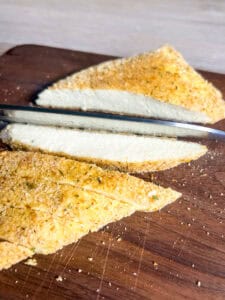

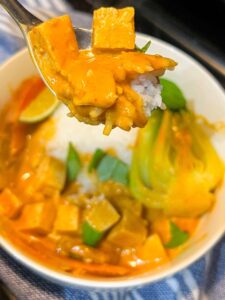
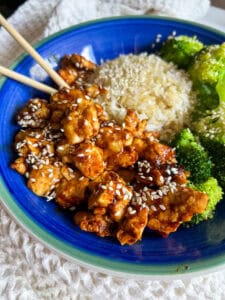
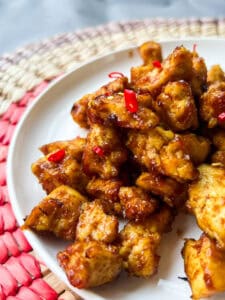
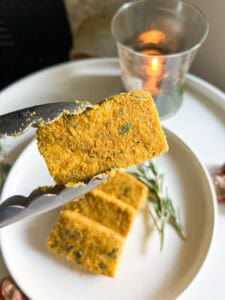

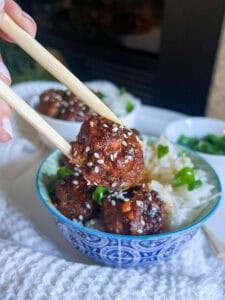
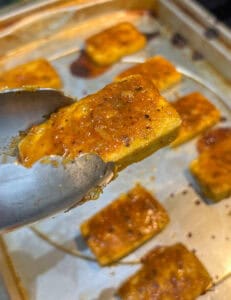

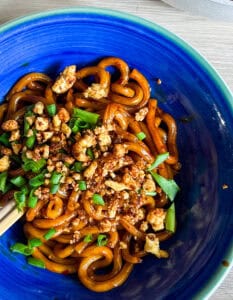



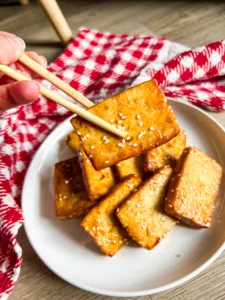
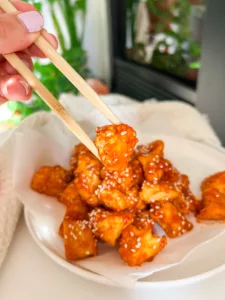
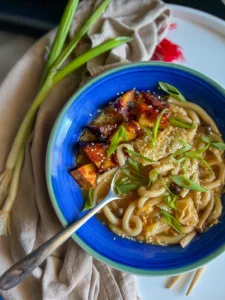
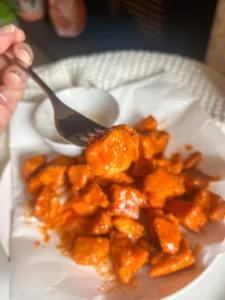


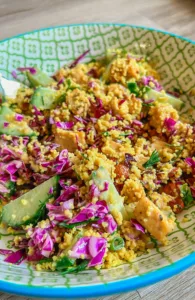
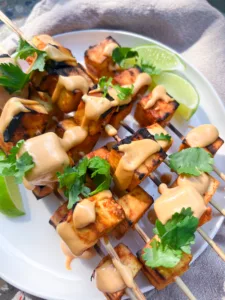

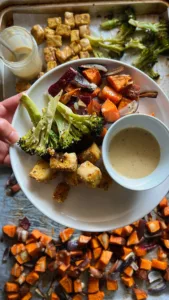
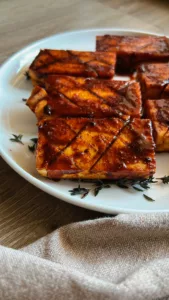



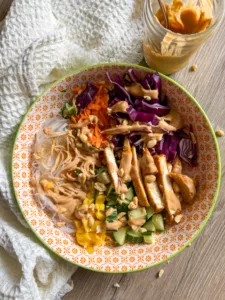




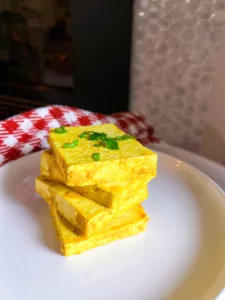

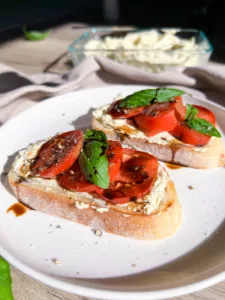


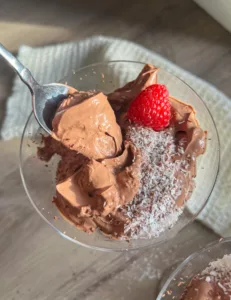
Great article and information thank you for compiling this together. Exactly what I was looking for and also looking forward to trying some of these delicious looking tofu recipes.
Hi John, thank you so much for the feedback I hope you enjoy some of my tofu recipes!
This was such a great and in-depth article thank you very much I have definitely learned a lot about what tofu is all about. I’m excited to try some of these techniques in the kitchen this weekend!
Thanks so much Debbie, and there are a lot of different type and ways to cook with tofu so I’m glad this article helped you out!
Wow so many types of tofu what is the best for someone new to eating tofu? Do they all just taste the same? I love the protein and nutritional aspects of tofu and looking to incorporate more into my diet this year.
Tofu indeed comes in various types, and they can differ in texture and taste. Tofu does have a mild taste on its own, making it versatile to absorb flavors from marinades and seasonings. For someone new to tofu, starting with extra-firm tofu and experimenting with different cooking methods and flavors is a good idea. Try marinating it in your favorite sauce, seasoning it well, and cooking until it achieves the texture you enjoy. As you explore, you might find your preferred type and preparation method. Enjoy incorporating tofu into your diet for its protein and nutritional benefits! If you have any specific preferences or questions, feel free to ask.
Great article and loving the tofu recipes thank you for this. Absolutely perfect ????
Thank you so much Robin! I’m so happy you found it helpful 🙂